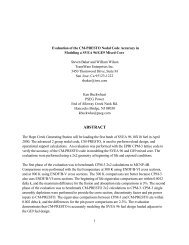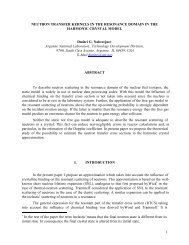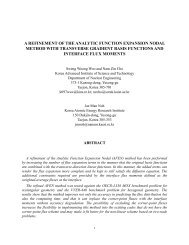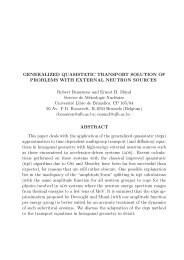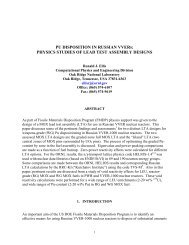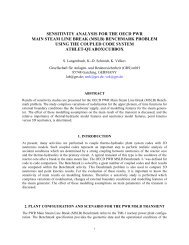J. Borkowski, K. Smith, D. Hagrman, and J. Rhodes, III
J. Borkowski, K. Smith, D. Hagrman, and J. Rhodes, III
J. Borkowski, K. Smith, D. Hagrman, and J. Rhodes, III
You also want an ePaper? Increase the reach of your titles
YUMPU automatically turns print PDFs into web optimized ePapers that Google loves.
6.1 S3R AS A PROCESS MODULE<br />
6. S3R INTEGRATION INTO WISE<br />
The S3R model was added to the WISE Visual Studio TM project as a WIN32 static library<br />
project. All S3R source code modules reside in this project group. Additionally, a global<br />
“Preprocessor Variable” was defined which allowed for a single source base to be maintained<br />
thoughout the project (Old core model exist along side S3R). Even though the S3R source was<br />
included in the project, its inclusion into the linked process could be turned on <strong>and</strong> off by the<br />
“Preprocessor Variable”, <strong>and</strong> during the compile process the source code would automatically<br />
configure itself for proper execution. The interface to S3R is through a single subroutine call<br />
with two passed arrayed parameters. One array is an input array <strong>and</strong> the other array is an output<br />
array. A small amount of wrapper code was added to pack <strong>and</strong> unpack the input <strong>and</strong> output<br />
arrayed data.<br />
6.2 TRANSIENT AND REAL-TIME PERFORMANCE<br />
S3R is a specialized version of SIMULATE-3K 3 . SIMULATE-3K is the transient analog of<br />
SIMULATE-3, also using the QPANDA nodal model. Thermal-hydraulic conditions are modeled<br />
using a five-equation Drift Flux fluid model coupled to a pin conduction model 4 .<br />
All reload core data comes from SIMULATE-3 restart files which are generated at multiple<br />
points in the cycle depletion. SIMULATE-3K reads the core follow nuclear data library directly.<br />
Real-time performance in the S3R implementation is achieved via parallel <strong>and</strong> serial<br />
accelerations of SIMULATE-3K. Parallel acceleration is achieved using threads. The major<br />
threaded modules are:<br />
• the tabular cross-section evaluation,<br />
• the thermal-hydraulic channel sweep,<br />
• the neutronic flux iteration,<br />
• the delayed neutron precursor integration, <strong>and</strong><br />
• the fission source evaluation.<br />
These modules account for 80 per cent of the required CPU execution time. The speed-up factor<br />
achieved via threading depends on the hardware. On average, 75 percent theoretical speedup is<br />
seen when taken across all threaded components.<br />
Serial acceleration is achieved by modifications to time-step, nodalization, <strong>and</strong> nuclear data<br />
evaluation. In all cases, S3R solves its field equations for every assembly radially <strong>and</strong> typically<br />
uses the following run time configuration:<br />
• 0.25 s time step,<br />
• 12 axial, 1 radial node per assembly,



